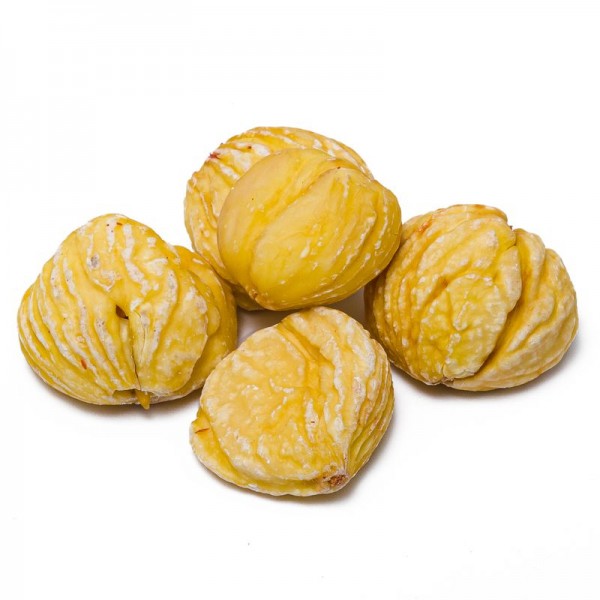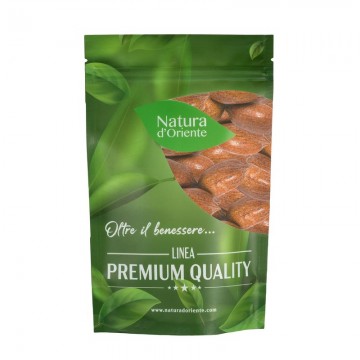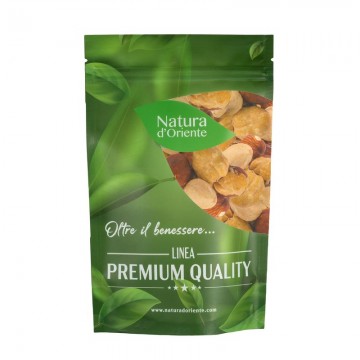The name chestnut is actually used for the fruits of different plants of the same genus. We refer naturally to the fruits of the European chestnut, in the dried version as regards the nutritional characteristics.
Dried chestnuts properties and benefits
Chestnuts are very rich in carbohydrates , dry ones in particular are a good source of vitamin B2 and vitamin B as well as some mineral salts.
Nutritional values of dried chestnuts
The nutritional values of dried chestnuts depend on how much water remains in the fruit, fresh chestnuts have a higher water content than dried fruit but definitely lower than fresh fruit (peaches, apples, etc.) which is 90% composed of water, in fact have a water content of 50%. One hundred grams of dried chestnuts with a residue of 10% of water provide 287 kilocalories, a high but much lower value than that of dried fruit in general. However, they are very rich in carbohydrates which, as we know, are complex sugars, so they are a real reserve of energy and fiber . As for the mineral salt content, the 738 mg of potassium stand out (about a quarter of the daily requirement, obviously if you do sports and sweat a lot the requirement changes). The 131 mg of phosphorus represents about one sixth of an adult's requirement which is about 800 mg per day.
Dried chestnuts in the diet
Carbohydrates are not to be demonized and therefore neither are chestnuts, they are an energy reserve that lasts longer than simple sugars. For those with asthenia or anemia problems, chestnuts are a invigorating food very suitable.
History and cultivation

The chestnut is found throughout the Mediterranean basin, from the Caspian Sea to the Atlantic. It is thought that it survived the last ice age in some shelters in southern Europe and in countries bordering the Mediterranean such as Lebanon. The findings of fossilized pollen indicate that the European Chestnut was probably first spread by man around 2000 BC. It probably spread first in the Greek world and from there in Italy starting with the Greek colonies, but the truth is that according to literary sources it seems that both the rich Romans and the Greeks did not appreciate it as a fruit, so it is difficult to be precise in the chronology because it was not widespread. A greater diffusion will begin in the Christian era, but not so much for food purposes but because they began to appreciate the versatility of wood. The cultivation of chestnut for food in Europe began to be really widespread only in the early Middle Ages and exploded in the late Middle Ages. In Italy in the mountain regions, chestnut flour will be an economic alternative to other flours for a long time. Later, however, it went to decline remaining in use only in pastry. Currently in the food industry of chestnuts a more qualitative than quantitative use is made and we are witnessing a rediscovery of this fruit based on the selection of quality products. Among the chestnut producing countries in the world, China and Korea stand out, but these are other species, the first European chestnut producer is Italy, some varieties are of particularly high quality. However, in many cases the European chestnut varieties have been hybridized with the Japanese chestnut which does not have a particularly good taste but has an important characteristic that it resists well to bark cancer caused by Cryphonectria parasitica. This devastating disease at the beginning of the last century almost wiped out the chestnut from the North American continent.
Plant and fruit
The scientific name of the European chestnut is castanea sativa, it belongs to the genus castanea and to the fugacee family. It is a rather large tree that if left to grow freely can reach 25-30 meters in height with a trunk of two meters in diameter. It is also a very long-lived plant, it normally lives 500 or 600 years, but in agriculture a well cared for plant can exceed a thousand years. The flowers are both male and female and are found on a catkin (a cluster inflorescence) the male flowers on top and female ones below. However, the plant cannot be self-pollinated, it needs cross-pollination (i.e. with the pollen of another moredoor carried by the wind or by insects). The dome (the characteristic shell with a thorny exterior that protects the fruits) in some varieties contains only one chestnut, in others up to three.
Using dried chestnuts in the kitchen
The recipes with chestnuts are many, as we said because of the sweet taste they are used in the confectionery industry, but in the kitchen they are also used in many savory dishes, not only in sweets. We chose a first course.
Chickpea and chestnut soup
Ingredients
- Dried chickpeas 300 gr
- Chestnuts 700 gr
- Laurel 2 leaves
- Fennel seeds to taste
- Water 1,2 lt
- Salt to taste
- Extra virgin olive oil 40 gr
- Black pepper to taste
- Garlic 2 cloves
- Rosemary 1 sprig
Preparation
Before starting the preparation, the dried chickpeas must soak for 24 hours. 1) Thoroughly rinse the chickpeas under running water and drain them 2) Boil the chickpeas in 1.2 liters of water for one hour. 3) (While the chickpeas are cooking) Wash the chestnuts, place them in a pan with cold water with the bay leaf and fennel seeds and cook them for 35-40 minutes from when it starts to boil or until they are tender. 4) Once the chickpeas have been cooked, turn off the heat and add salt (avoid salting them during cooking as they would harden). 5) Peel the chestnuts and collect the pulp in a bowl, crumbling it coarsely 6) Peel the garlic and slice it thinly. 7) Heat a drizzle of olive oil in a pan, add the sliced garlic and sauté 8) Pour the crumbled chestnuts and make sure they are flavored. 9) Finally add the chickpeas with their water 1 10) Flavor with a sprig of whole rosemary so it will be easier to remove it, 11) Add salt and pepper and continue cooking for another 15 minutes, stirring often. 12) Once the cooking time is over, the chestnuts will have partially melted. Serve the chickpea and chestnut soup hot with a drizzle of oil and a little ground pepper to taste.
Recipe source: Saffron Yellow < / a>













 No reward points for this product.
No reward points for this product.

















